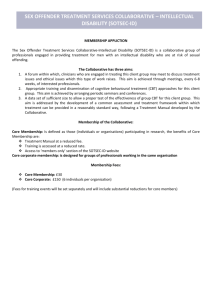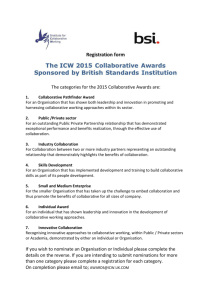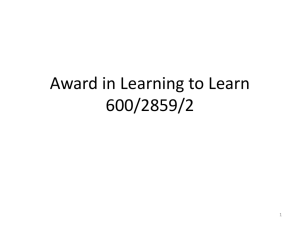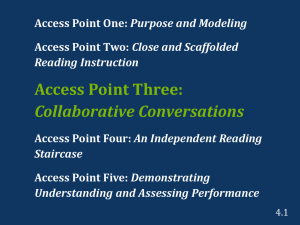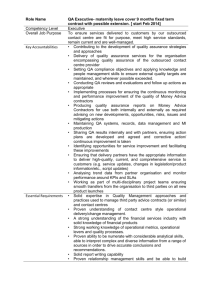Collaborative Risk Assessment
advertisement
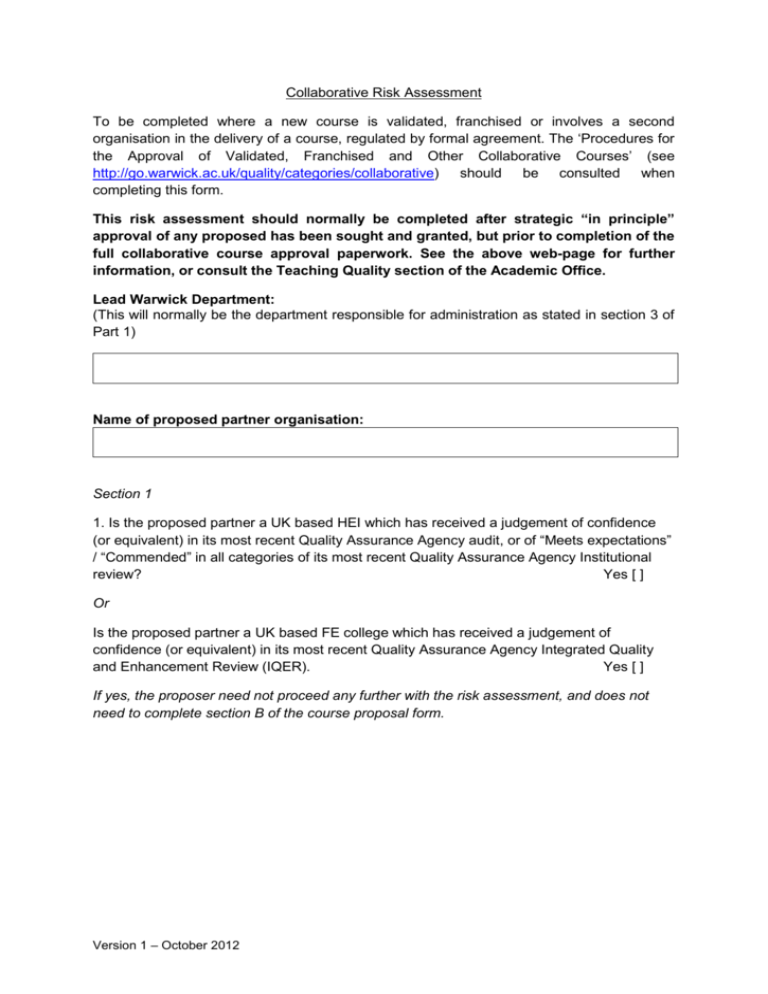
Collaborative Risk Assessment To be completed where a new course is validated, franchised or involves a second organisation in the delivery of a course, regulated by formal agreement. The ‘Procedures for the Approval of Validated, Franchised and Other Collaborative Courses’ (see http://go.warwick.ac.uk/quality/categories/collaborative) should be consulted when completing this form. This risk assessment should normally be completed after strategic “in principle” approval of any proposed has been sought and granted, but prior to completion of the full collaborative course approval paperwork. See the above web-page for further information, or consult the Teaching Quality section of the Academic Office. Lead Warwick Department: (This will normally be the department responsible for administration as stated in section 3 of Part 1) Name of proposed partner organisation: Section 1 1. Is the proposed partner a UK based HEI which has received a judgement of confidence (or equivalent) in its most recent Quality Assurance Agency audit, or of “Meets expectations” / “Commended” in all categories of its most recent Quality Assurance Agency Institutional review? Yes [ ] Or Is the proposed partner a UK based FE college which has received a judgement of confidence (or equivalent) in its most recent Quality Assurance Agency Integrated Quality and Enhancement Review (IQER). Yes [ ] If yes, the proposer need not proceed any further with the risk assessment, and does not need to complete section B of the course proposal form. Version 1 – October 2012 Status of partner For Existing Partners 2. Score one point for every item on the list below that the partner demonstrates in relation to this proposed collaboration: Recently established collaborative partner of less than 3 years standing No existing provision in the same subject area No existing provision at same level of study or higher Adverse External Examiner comments or problems identified through monitoring Subject area that the University has little or no experience in Go straight to question 10. For New Partners 3. How would you categorise the proposed partner? Publicly funded HEI Private HEI FE College Other educational organisation Any other type of organisation [ ] 1 point [ ] 2 points [ ] 3 points [ ] 5 points [ ] 6 points 4. What is the new partner’s financial status? Well funded by state or regional authorities Profitable private organisation Poorly funded by state or regional authorities Poorly funded private organisation, or incomplete financial record [ ] 1 point [ ] 2 points [ ] 4 points [ ] 5 points Proposals scoring 2 points or above on this question should ensure that they include document A (see section 3). 5. How robust are the new partner’s quality assurance processes? Well defined and robust and auditable Processes are in place, but cause for concern regarding rigour No formalised/clear quality assurance processes in place. [ ] 1 point [ ] 4 points [ ] 6 points Proposals scoring 4 points or above on this question should ensure that they include documents B and C (see section 3). Country of Collaboration 6. What is the socio-political context of the country that the partner is based in? Stable Politically unstable (FCO – essential travel only/travel prohibited) Version 1 – October 2012 [ ] 1 point [ ] 10 points [] [] [] [] [] 7. What is the economic context of the country that the partner is based in? Major economic power Developed world Emergent Economy Developing world [ ] 1 point [ ] 2 points [ ] 4 points [ ] 5 points 8. What is the educational context of the country that the partner is based in? UK-based system European or North-American based system Other developed system Developing system [ ] 1 point [ ] 2 points [ ] 4 points [ ] 5 points Prior Collaborative Experience 9. What experience has the partner had in running academic collaborations with UK HE institutions? Currently runs collaborative programmes at this level Currently runs collaborative programmes at a lower level No experience of UK HE collaborative programmes [ ] 1 point [ ] 3 points [ ] 6 points Collaborative Model 10. What is the type of collaboration proposed? Franchised course(s) Validated course(s) Distance delivery Double/Joint award Other collaborative arrangement [ ] 1 point [ ] 2 points [ ] 3 points [ ] 4 points [ ] 5 points 11. What will be the role of the partner? Not involved in the academic delivery of the course Delivery of a franchised course Delivery of a validated course Joint delivery of some or all aspects of course [ ] 1 point [ ] 1 point [ ] 2 points [ ] 4 points 12. What is the highest level of the proposed course? Level 5 (e.g. Foundation Degree) Level 6 (e.g. Bachelors Degree) Level 7 (e.g. Masters Degree) Level 8 (e.g. Doctoral level study) Version 1 – October 2012 [ ] 1 point [ ] 2 points [ ] 3 points [ ] 4 points Risk band Add together the points scored in all questions, and indicate the total. Please enter the total score below. Low risk Medium risk High risk 0 – 13 points 14 – 26 points 27 - 56 points Version 1 – October 2012 [] [] [] Section 2 The risk category identified in section 1 will inform the level of background documentation you will need to supply. Proposals should be accompanied by the documents covering the areas indicated in this table, as indicated by the risk category. Please answer yes or no on each line of the table in the relevant column. If you wish, you may number the accompanying documents, and cross-refer from this table to those document numbers. One supporting document may address a number of areas in the table. Please use the final column to add any comments, including any special features of provision or variations to the institution’s normal procedures as they will apply to this collaborative course. Documents to be included for each risk category (marked with an X) A covering letter from the partner organisation setting out: Its reasons for seeking the partnership, a statement of commitment to the collaboration and special organisational features which support its suitability Its legal status and its ability to contract with the University. A register of its existing collaborative relationships with other Higher Education Institutions, on the understanding that the University may contact any of these with a view to obtaining the opinion of an existing partner on its collaborative relationships with the prospective partner. A commitment to deliver the relevant aspects of the collaborative course itself, not via a third party or involving the use of agents of any kind An outline of the structure for student support and pastoral guidance An outline of the structure for student feedback, e.g. SSLCs, questionnaires etc The mission statement and objectives of the partner organisation A plan or chart of the institution’s organisational structure The institutional policy and procedures for the appointment, induction, appraisal and development of staff. The institution’s most recent prospectus Version 1 – October 2012 Low Medium High X X X X X X X X X X X X Included (Yes/No) Document Number Comments Additionally for overseas organisations: Information about the institution obtained from the British Council and the National Academic Recognition Information Centre (NARIC) where applicable/available Information about the organisation from UK and indigenous government offices and agencies Information on the potential effects upon the partner’s ability to exercise its responsibilities for academic standards and quality of local cultural, legal, financial and political factors, including any legal requirements by national government/quality assurance and/or professional bodies; whether any such approvals have been obtained and, if not, the locus of responsibility for doing so Evidence of the experience of the institution in delivering comparable courses at the same level Evidence of the institution’s understanding of the elements underpinning the University’s quality framework which would be applicable to the prospective partner such as the External Examiner system; Staff Student Liaison Committees; Annual and Periodic Review and access for students to academic and pastoral support and guidance X X X X X X X X Section 3 Additional documents required, as indicated by your response to specific questions in section 1. Document A B C Included (Yes/No) The institution’s last three sets of annual published financial accounts. (These will be reviewed by the University’s Finance Office and should be sent to the Head of Reporting, Finance Office in the first instance. The Finance Office may subsequently decide to run a check through a credit agency, and the department should ensure that the prerequisite time is built into the application process to accommodate this requirement.) Reports on the prospective partner from funding, or external quality assurance, bodies at institutional and departmental levels. The institutional quality assurance strategy or equivalent Version 1 – October 2012 Document Number Comments
